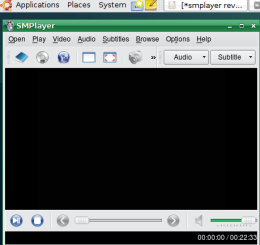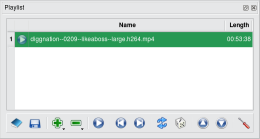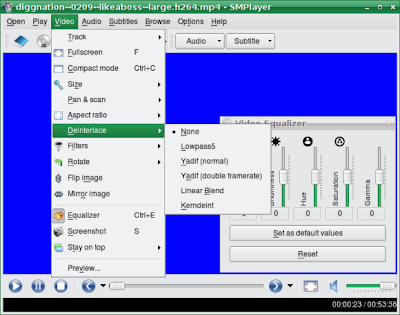 For me the the best free media player for Windows and Linux is mplayer. It is not only a very fast player, but it also offers a ton of advanced options. The one thing that it lacks is a good graphical user interface to access all the power it has under the hood. Several GUI front ends have been written for mplayer, but in my opinion there is one that stands head and shoulder above the others: Smplayer.
For me the the best free media player for Windows and Linux is mplayer. It is not only a very fast player, but it also offers a ton of advanced options. The one thing that it lacks is a good graphical user interface to access all the power it has under the hood. Several GUI front ends have been written for mplayer, but in my opinion there is one that stands head and shoulder above the others: Smplayer.
Smplayer Installation
Smplayer is very easy to install on Ubuntu (and Linux Mint) as the author provides deb packages for all versions of Ubuntu since gutsy (7.10). The packages are in a PPA repository that you can add to your Ubuntu sources list to automatically receive updates to both Smplayer and Mplayer. Note that the application is also present in most Linux distribution's repositories and that you can always compile the latest version of the program from the author site. Packages for Windows are also available there. These include all the prerequisites for the program such as mplayer and QT in addition of Smplayer itself.
Playback Control One of the huge advantage of Smplayer is the amount of control that you get over the playback of your video files. You can easily build and save playlists with all the features you would expect from a modern player like shuffle or repeat. Seeking is extremely easy: not only can you use a seek-bar but pressing the left or right arrows on your keyboard will jump the file 10 seconds and the up and down arrows will jump one minute. It is a feature I can't live without anymore, as it is much faster and easier to seek with the keyboard than with the seek-bar. One extra nice feature of Smplayer is that if you close it your position in the file you were playing and its settings will be restored the next time you open that file. Zooming in the picture is also extremely easy, just pressing E or Q will zoom in or out by small increments. Thanks to this it becomes a cinch to adjust a video file in 3/4 to a 16/9 screen.
One of the huge advantage of Smplayer is the amount of control that you get over the playback of your video files. You can easily build and save playlists with all the features you would expect from a modern player like shuffle or repeat. Seeking is extremely easy: not only can you use a seek-bar but pressing the left or right arrows on your keyboard will jump the file 10 seconds and the up and down arrows will jump one minute. It is a feature I can't live without anymore, as it is much faster and easier to seek with the keyboard than with the seek-bar. One extra nice feature of Smplayer is that if you close it your position in the file you were playing and its settings will be restored the next time you open that file. Zooming in the picture is also extremely easy, just pressing E or Q will zoom in or out by small increments. Thanks to this it becomes a cinch to adjust a video file in 3/4 to a 16/9 screen.
The Smplayer Interface
I am a big fan if the classic media player interface which Smplayer mimics: menus on top, video window in the middle and playback controls on the bottom. Most videos are viewed full screen however and in this case you can control the playback with an auto hiding control bar at the bottom of the screen. For it's widgets Smplayer uses QT 4, which is a good choice in my opinion. The application will look its best in a KDE environment, but does not look out of place on Windows or on the Gnome-based Ubuntu. Note that Smplayer does support themes and that a Gnome theme is available if you really can't stand the QT look. Advanced Options
Advanced Options
There area plethora of advanced option that Smplayer let you access easily. You get a graphical video equalizer, several de-interlace modes (including the excellent yadif), post-processing options and a bucketload of video filters. Smplayer can also take advantage of XV / XVMC video acceleration on Linux / Ubuntu (if your video driver supports it) and of DirectX acceleration on Windows. Fully accelerated video decoding is not yet available however (see here for a more detailed explanation of video decoding acceleration). Sound-wize you can adjust delay to solve synchronizations errors and use a few useful filters like volume normalization. Subtitles are supported and you can adjust their size and delay. Power users will appreciate the option to send command line style arguments to Mplayer directly.
Codec Support and DVDs
Since Smplayer is based on Mplayer it can read most video and audio files out of the box. All common formats are supported: MPEG1, MPEG2, MPEG4, DivX, Xvid, H264, Flv, MKV, Avi, Mov, mp4, Ogm, Mp3, AAC, Ogg etc... There is a codec pack (Win32 codecs) to enable support for more formats. Smplayer can also read DVDs and the author recently added the ability to navigate them using the traditional DVD menus (this is still experimental). On Linux / Ubuntu you will need libdvdcss to be installed to view encrypted DVDs but once that library is present it worked fine for me.
Conclusion
In my opinion Smplayer is the best media playback solution on Ubuntu, followed by VLC and Totem. On Windows there is more competition but I still Find Smplayer to be the most practical solution thanks to the advanced features and because of the extensive codec support. Definitely recommended.
UPDATE: the developer of Smplayer was kind enough to grant me an interview that you can read here.
For more posts like this subscribe to Tech-no-Media (rss) or Follow me on Twitter.
A Review of the Smplayer Media Player for Linux and Windows
Posted on Monday, July 6, 2009
by Erlik
Subscribe to:
Post Comments (Atom)




1 comments:
"Linux / Ubuntu"? But... Ubuntu IS a Linux distro!
Good review. You've pretty much pointed out all of SMPlayers strengths.
Post a Comment